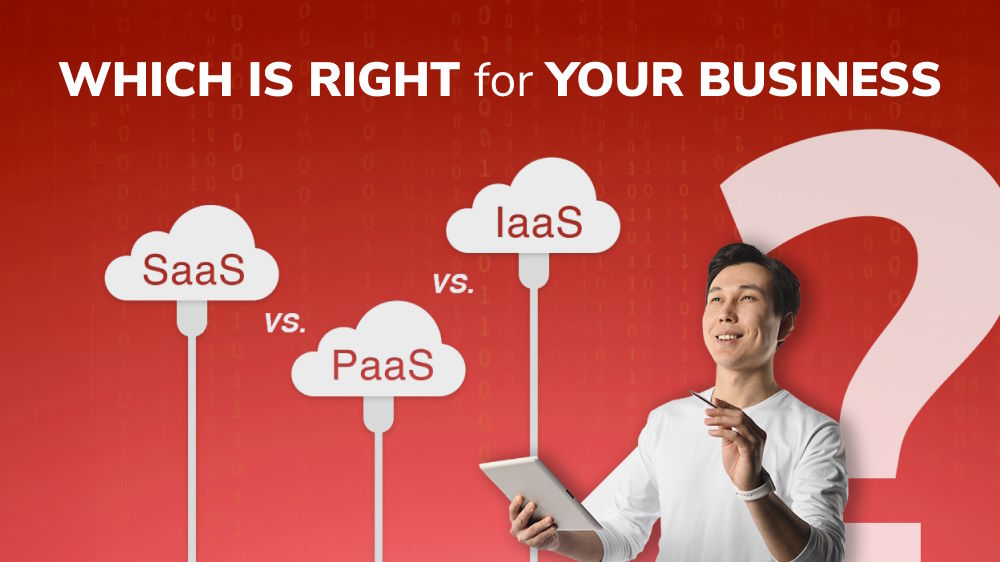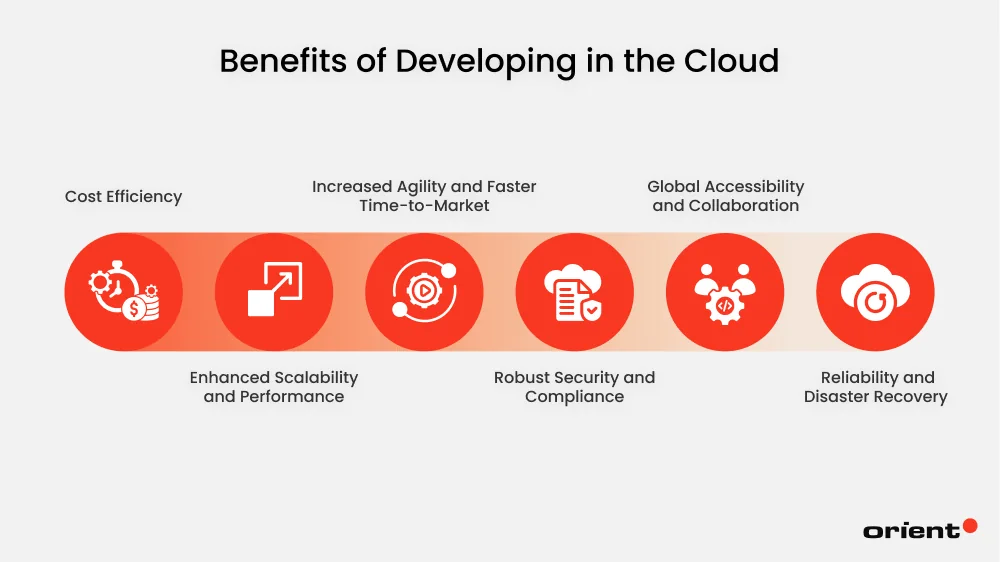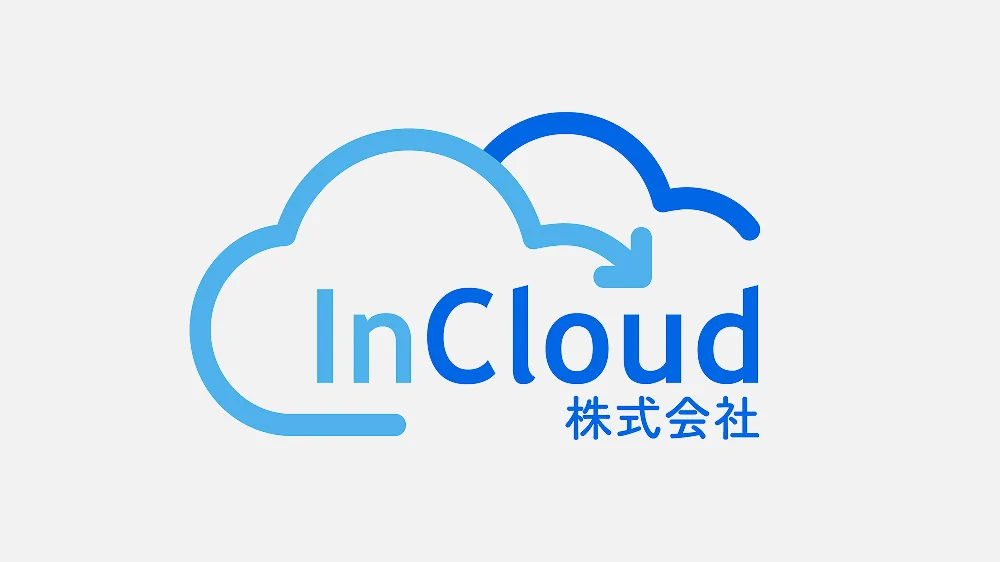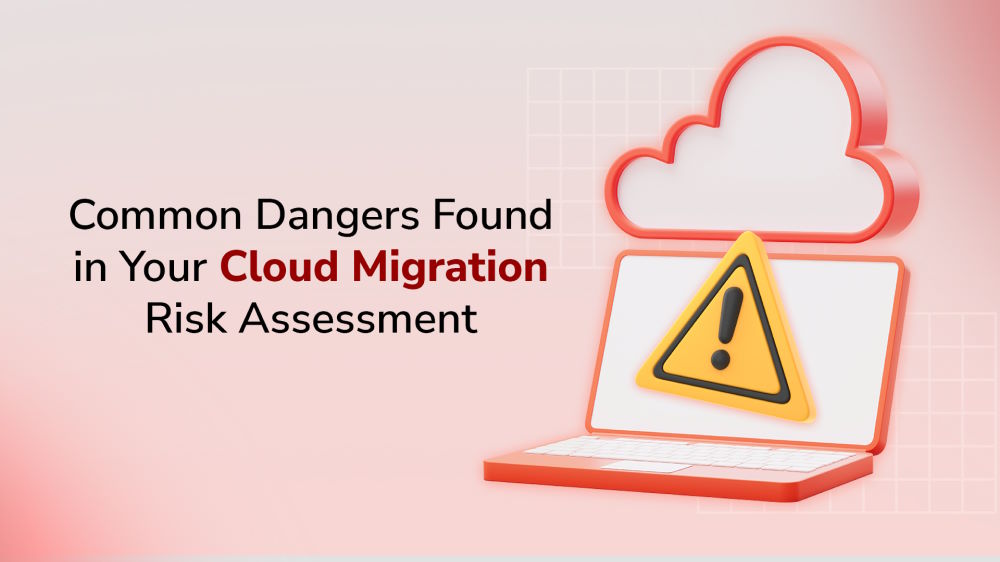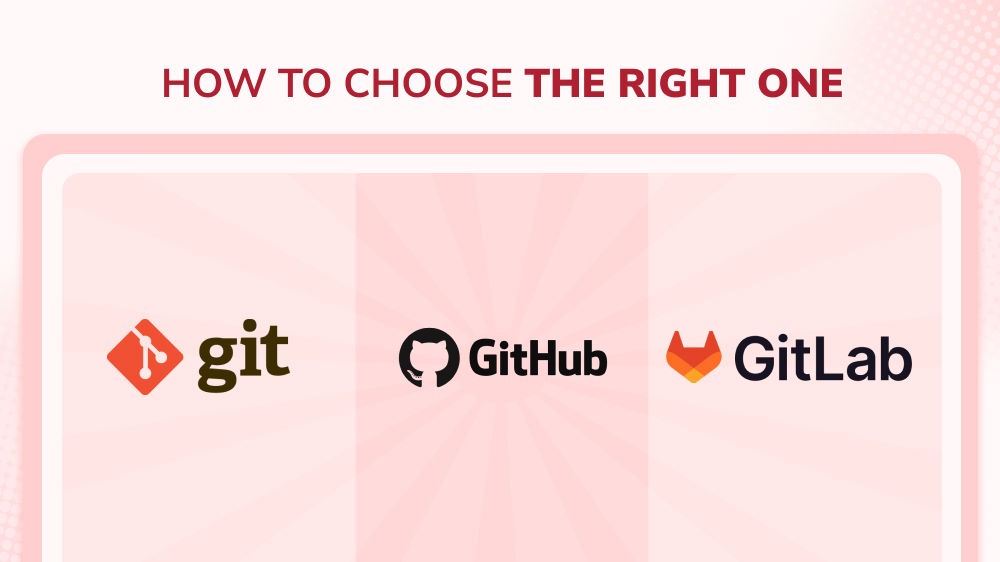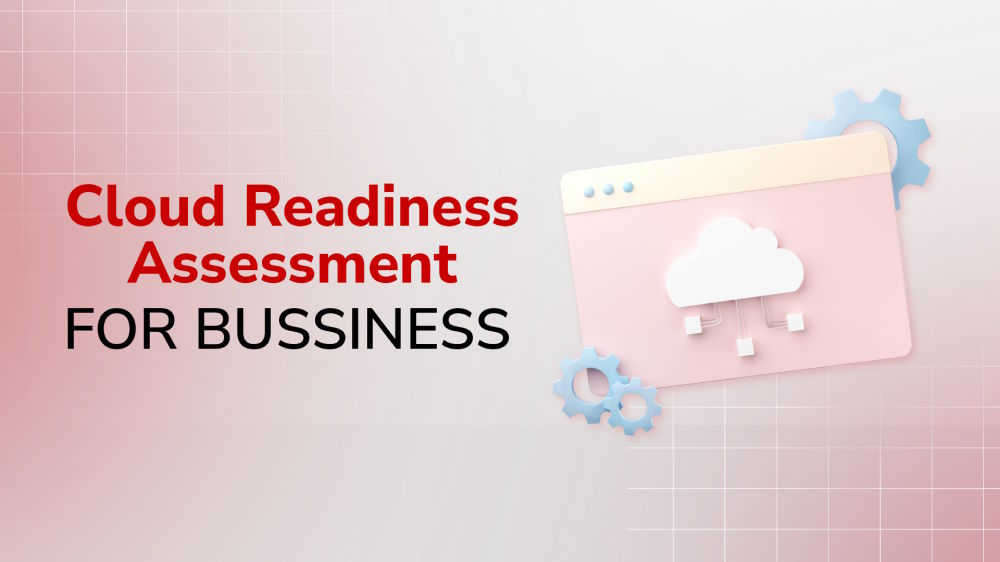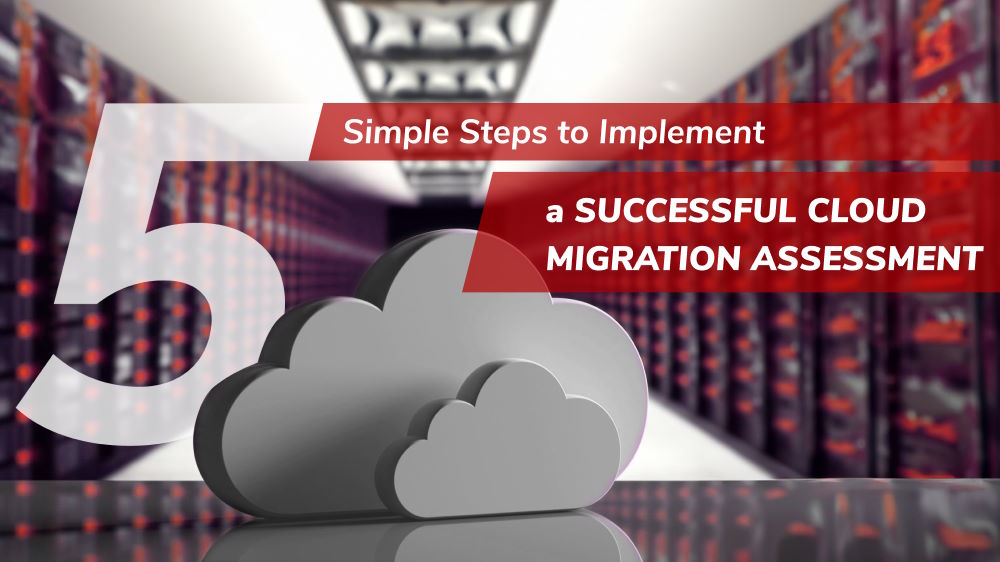Industry forecasts predict that over 50% of IT spending will shift from traditional tools to cloud solutions by 2025, and over 95% of all new digital workloads will be developed and run on cloud-native platforms.
This profound change is driven by a simple but powerful fact: cloud application development unlocks a combination of benefits that on-prem solutions can’t match. From instant scale-out to massive cost savings in operational costs, the cloud provides the flexibility and dependability required to thrive. Read this post as your introduction to the definitive arguments why the cloud isn’t just a preference, but an imperative for your next application.
For any company that is looking to build an application that is capable of standing on its own in the digital-first world, the question is not anymore “should we move to the cloud?” but rather “how soon can we get there?”
What Is Cloud Application Development?
The development of cloud applications is the process of designing, building, testing, and delivering software applications that implement cloud computing platforms like Amazon Web Services (AWS), Microsoft Azure, or Google Cloud Platform (GCP) environments instead of implementing conventional dynamically hosted servers. These are applications that utilize the distributed characteristics of the cloud infrastructure, hence being able to utilize the processing power, data storage, and network resources on demand through the internet.
As an example, an AWS-based cloud-native e-commerce platform could incorporate Amazon EC2 for compute, Amazon S3 as storage, and AWS Lambda to process backend logic, decrease the capacity of physical servers, and facilitate deployment and maintenance.
Key Characteristics of Cloud-Based App Development
The introduction of cloud-based application development delivers some distinctive architectural and operational characteristics:
- Elastic Scalability: Applications can elastically scale resources, both up and down, according to need, through autoscaling and thus avoid performance bottlenecks and wasting resources during low utilization.
- Resilience and High Availability: Cloud app development platforms support redundant data centers in various geographical areas so that they provide fault tolerance and disaster recovery. This implies that applications would still be able to use them in case of the breakdown of one of the servers or the number of places one chooses.
- Modularity with Microservices: In cloud apps, microservices architecture is used in which services are partitioned into small and independent services. The separate deployment of each of the services and the independent scaling of them allows making the complete system more agile and maintainable.
- Automation and Serverless Computing: Cloud technology supports high degrees of automation with patterns like Infrastructure as Code (IaC), which employs scripts to provision and manage the infrastructure. This limits manual error and speeds up deployment. Further, serverless computing allows developers to write and run applications without provisioning or dealing with anything related to servers.
Cloud App Development vs. Traditional On-Premises Development
The differences between cloud and on-premises application development are stark and transformative:
| Feature | Cloud Application Development | On-Premises Development |
|---|
| Infrastructure | Hosted on third-party cloud platforms | Hosted on local servers managed by the organization |
| Cost Model | Pay-as-you-go, subscription-based | Capital expenditure for hardware and maintenance |
| Scalability | Instant scalability using virtual resources | Requires manual hardware upgrades and provisioning |
| Deployment Speed | Rapid, automated CI/CD pipelines | Longer deployment cycles due to manual processes |
| Accessibility | Globally accessible via the internet | Restricted to local networks unless specially configured |
| Maintenance | Managed by cloud providers with regular updates | Internal teams handle upgrades, security patches, and downtime |
Essentially, cloud application development allows businesses to become even more agile, cost-effective, and innovation-oriented—qualities that are becoming more and more necessary in the realm of the current competitive digital environment.
Benefits of Developing in the Cloud
Developing an application in the cloud is a wise decision that promises real value to an organization, including financial savings and operational flexibility.
![Benefits of Developing in the Cloud]()
Cost Efficiency
The cloud-based development changes the financial model of the company at its core and transforms such huge capital expenditure (CapEx) into flexible operational spending (OpEx). When using a pay-as-you-go model, the businesses are only charged for the exact resource they use, which is measured in minutes and sometimes even seconds. This is in sharp contrast to the classic on-premises development in that a firm has to pay a huge one-time fee to acquire servers and networking hardware, and in most cases, over-purchase capacity in anticipation of future expansion.
The cloud also removes the cost and consideration of purchasing hardware as well as the expenses of running a data center where the physical infrastructure is run by the cloud company. Additionally, it substantially lowers maintenance expenses in maintaining power, cooling, and staff workforce tasked with management of a physical data center.
Enhanced Scalability and Performance
The type of scalability and elasticity that is offered with cloud environments cannot be achieved with on-premises infrastructure. On-demand resource provisioning can be configured on an application and automatically adapt to any variation of user demands. As an example, an e-commerce site can automatically increase the capacity of its servers to accommodate huge volumes of traffic during a sale period or holiday season, and then reduce it once the event is over, without the need to do it manually.
This avoids the possibility of performance degradation and outages when traffic spikes, therefore providing an uninterrupted, smooth user experience for all users, which is a key success factor in terms of customer satisfaction and retention.
Increased Agility and Faster Time-to-Market
The cloud radically increases the speed of development and enables companies to release new products and features in a way never before seen. Developers are able to instantly deploy an entire development or test environment within minutes, instead of the days or weeks it may take IT to provision physical servers. This mobility is further enhanced by the built-in clouds that aid the Continuous Integration/Continuous Deployment (CI/CD) pipelines that automate the code constructing, testing, and deploying procedures.
When these automated processes are combined, teams can make releases and introduce new features several times per day, freeing them up to pursue innovation and product distinction rather than the tedious, time-consuming responsibilities of infrastructure management.
Robust Security and Compliance
Leading cloud service providers spend billions of dollars on cybersecurity and provide a more secure and stable environment than most organizations could possibly develop on their own. This is characterized by the shared responsibility model: the cloud provider is in charge of the security of the cloud (its physical data centers, hardware, and the core networking), whereas the customer is in charge of the security in the cloud (managing data, configuring access controls, and securing applications).
Cloud infrastructures provide a set of comprehensive data security options that are simple to use, such as Identity and Access Management (IAM) to administer user access, automated encryption of data at rest and on the go, and sophisticated network security firewalls. Moreover, they have high compliance certification, including GDPR, HIPAA, and PCI-DSS, and it allows companies to achieve compliance much easier, even with the complicated regulatory frameworks.
Global Accessibility and Collaboration
When built on the cloud, applications are naturally globalized, with an aim of reaching far-flung audiences. With a few clicks, an application can be deployed to serve customers in multiple geographical areas and availability zones and be used with a low-latency connection across the globe without the need to construct a single physical data center.
This worldwide availability also enables distributed teams and remote workers, where developers and stakeholders can locally access the same development environments and scale and work in synchrony in virtually any geographical location, on any device.
Reliability and Disaster Recovery
The cloud providers develop their infrastructure utilizing extreme redundancy to make high availability possible. Deploying applications in a subset of physically dispersed data centers within the region provides a company with the ability to ensure that in the scenario where one of the data centers were to fail, a given application would seamlessly fail over to the other data center online. This offers a degree of reliability that would be prohibitively costly to carry out on-premise.
Furthermore, cloud application development services provide effective backup and recovery plans via automatic data backups and snapshots. This will make it much easier to back up and restore an application and its data in case of a disaster, which could drastically reduce downtimes and limit possible business losses.
Is the Cloud Right for Everyone?
While the benefits of cloud based solutions are extensive, businesses must be aware of the potential challenges and have a strategy to navigate them.
![Is the Cloud Right for Everyone?]()
The Myth of “Vendor Lock-in”
A vendor lock-in is one possible issue where companies overcommit to a specific cloud infrastructure provider environment but find it challenging or expensive to change services in the future. Although this is an appropriate consideration, there are practical methods of mitigating the risk:
- Multi-Cloud Architectures: The flexibility will be ensured by deployment of applications on various clouds (e.g., AWS will provide the compute capabilities needed; Azure provides the storage requirements). Should any one of the vendors increase prices or reduce features, there is little disturbance, and they are able to transfer workloads.
- Cloud-Agnostic Tools: Frameworks such as Terraform, Kubernetes, and Docker enable programmers to create infrastructure and containers that can be run equally across cloud vendors.
- Open-Source Technologies: Choosing open-source frameworks and databases (e.g., PostgreSQL, Apache Kafka) over proprietary solutions reduces dependency on vendor-specific configurations and licensing models.
By designing with portability in mind from the beginning, businesses can future-proof their application strategy and maintain leverage with providers.
Security and Compliance
Although large cloud providers spend billions of dollars securing their infrastructure, there is a widespread misconception that this means the cloud is secure by default. In fact, cloud-based security works on a Shared Responsibility Model. The security of the cloud (i.e., physical security of their data centers, underlying hardware, and network) depends on the cloud application development platforms (e.g., AWS, Azure).
The security in the cloud is, however, left to the customer. This encompasses very important tasks like setting up the correct identity and access management (IAM) rules, data encryption, and proper setup by establishing the correct security groups and network settings to avoid unauthorized access. The most common causes of a breach are a misconfiguration on the side of the customer instead of defects in the infrastructure of a cloud provider.
Companies should thus invest in a comprehensive security plan that involves constant observation, periodic audits, as well as tight access controls to secure their company applications and ensure they align with industry laws such as the HIPAA, GDPR, or SOC 2.
The Initial Learning Curve and Skills Gap
The movement towards cloud application development is not simply a facial technological change, but it is also cultural and operational. It has a steep initial learning curve, which may be a challenge to the teams that are used to traditional on-premises environments. Operations engineers and developers will have to learn a set of new skills, such as cloud-native computing, serverless computing, and automation frameworks, such as Terraform or CloudFormation.
They must get to know novel service products, including managed databases and message queues, machine learning APIs, and content delivery networks. This necessitates a very important investment towards upskilling current draw by getting them certified, on-the-job training, and nominal time spent in learning activities.
Although the cost of initial knowledge seems too much, it is a step in the direction of creating a more agile, efficient, and future-proof engineering organization. Over time, these skills will enable the team to leverage the full power of the cloud and drive sustained innovation.
Cloud App Development Process
Developing a cloud-native application involves a series of well-defined steps that integrate strategic planning, modern architecture, and cloud-native tools.
![Cloud App Development Process]()
Planning: Assessing Business Goals and Cloud-Readiness
The cycle does not start with code; it starts with a tactical evaluation. The stage presupposes immersion in business objectives to establish the purpose of the application, target audience, and key performance indicators (KPIs).
The most important is the cloud-readiness assessment, which is used to analyze the current IT infrastructure, pool and security and compliance needs of an organization. This step identifies whether the company is ready to pursue the cloud-first strategy or a hybrid one as the next step.
The output will be an overall project roadmap that will summarize the basic functionality of the application, a top-level plan, and a clear idea of the expected gains in the form of return on investment (ROI) by utilization of the cloud.
Architecture Design: Choosing Your Foundation
Having a good plan of action, attention is now directed to architectural design. The cloud provides various paradigms, and the selection of the appropriate one is paramount to scalability, cost, and maintenance.
- Microservices: This is an architecture that divides a big application into a set of small services that can be separately deployed and delivered through APIs. It is a perfect choice in complicated applications with high requirements in meeting availability and constant delivery of features because teams will be able to continue creating a service without interference with the whole system.
- Serverless: This architecture, facilitated by microservice architecture, enables developers to execute code without equipping or managing servers. A developer just uploads code, and the cloud provider automatically provides the required resources and scales as needed. This solution is extremely economical in event-driven, discontinuous workloads (e.g., picture processing or scheduled jobs) since you can only pay when the code is run.
- Containers: Applications alongside all of their dependencies (libraries, frameworks) are bundled into one portable unit: containers. This makes the application behave consistently across various platforms, from a locally powered developer to the production server. Orchestrators such as Kubernetes are utilized to manage containers in order to automate and scale the systems, deployment, and networking, and offer a highly flexible and efficient method of managing complex applications.
Selecting a Cloud Provider and Tooling
The selection of a cloud provider is based on the service offerings, pricing, global reach, and developer tooling. There are three main market players, and each player has defined strengths.
| Feature / Provider | AWS (Amazon Web Services) | Microsoft Azure | Google Cloud Platform (GCP) |
|---|
| Market Share | Market leader with the largest global footprint and service offerings. | Strong second, particularly with large enterprises and existing Microsoft users. | Growing rapidly, especially in data-centric and AI-focused sectors. |
| Key Strengths | Breadth and depth of services, developer tools, and an enormous ecosystem. | Seamless integration with Microsoft enterprise products (Office 365, Active Directory). Strong hybrid cloud support. | Leading innovation in AI/ML, Big Data, and analytics. Excellent performance for data-intensive workloads. |
| Pricing Model | Complex but granular pay-as-you-go. Offers significant discounts with Reserved Instances. | Also pay-as-you-go, with deep discounts for Microsoft license holders. | Known for being more affordable for certain workloads with per-second billing and committed-use discounts. |
| Use Case Fit | Startups to large enterprises needing maximum flexibility and a massive service catalog. | Businesses with existing Microsoft investments or a preference for a unified vendor ecosystem. | Companies focused on data science, machine learning, and cutting-edge cloud-native technologies. |
Development: CI/CD, APIs, and Testing
After the architecture and platform decisions are made, the rapid and trustworthy development stage comes into focus:
- CI/CD Pipelines: An automated workflow of build, test, and deployment using services such as AWS CodePipeline, Azure DevOps, or Google Cloud Build.
- API-First Development: RESTful APIs or GraphQL APIs are used to provide the core structure of service interaction. Traffic control, security, and analytics are facilitated by gateway services, such as Amazon API Gateway or Azure API Management, which can be provided.
- Testing in Cloud Environments: Cloud testing tools enable unit, integration, and load testing to run directly inside staging environments and keep them consistent prior to general release.
This stage also involves writing automation scripts to run infrastructure builds and getting monitoring tools on-boarded early so issues can be caught before becoming too serious.
All of this entire process happens automagically, and developers can merge their code regularly and detect the bugs early on in this lifecycle, and thus the chances of a bugged deployment are minimized to a very significant extent.
Deployment: Managing Environments with IaC
Deployment is no longer a manual, error-prone task. It is handled by Infrastructure as Code (IaC), which uses a declarative language to define and provision cloud resources. Tools like Terraform or AWS CloudFormation allow developers to describe the desired state of their infrastructure (e.g., “I need a load balancer, two virtual servers, and a managed database”) in a script.
When executed, the tool automatically provisions and configures all the required resources. It secures consistency in all environments (development, staging, and production), removes configuration drift and exposes all the deployments to be repeatable and auditable.
Monitoring and Optimization with Cloud-Native Tools
The prerequisite to maintaining high performance and reliability of the operations running in the cloud is the continuous monitoring and optimization of the operations in the cloud:
- Azure Monitor offers real-time metrics, dashboards, and alerting combined with Log Analytics and Application Insights.
- Amazon CloudWatch monitors infrastructure metrics, logs, and custom KPIs and is integrated with auto-scaling policies.
- The Operations Suite provided in GCP helps to trace, log, and monitor the uptimes of distributed systems.
Moreover, APM (Application Performance Monitoring) and the ability to detect anomalies enable teams to detect bottlenecks, security events, or resources that are underutilized, which are becoming a way forward to cost savings and making proactive decisions.
Success Stories: How Orient Software Can Be Helpful?
Along with a successful history of helping businesses modernize their technology stack and scale their operations, Orient Software has created a reputation of being strategic in cloud application development. We assist clients to eliminate technical boundaries and achieve their business goals by offering professional teams and the use of the latest architectural solutions.
InCloud: Reducing Operation Costs by 50% and Ensuring Scalability
![InCloud]()
Orient Software partnered with InCloud, a Japanese-based technology company, to meet its need for quality development resources as well as a cost-effective, scalable cloud environment. With a growing number of projects in InCloud’s portfolio, its existing infrastructure was limited in scalability and cost. The core challenge was the replacement of a DynamoDB service that was increasingly expensive to run while being able to handle increasing workloads without affecting performance.
Orient Software assembled a dedicated team of AWS and Python experts that seamlessly integrated into InCloud’s operations. The team’s response was a well-designed migration to a scalable AWS platform that addressed the client’s cost and performance issues explicitly.
This engagement implemented a remarkable 50% reduction in operating costs by transitioning to the new AWS solution while maintaining the necessary performance and security. This collaboration not only solved InCloud’s immediate problems but also established a long-term partnership, demonstrating Orient Software’s ability to provide authentic, budget-friendly solutions through professional cloud application development.
Plenti: Transformation for High Performance and Agility
![Plenti]()
One of Australia’s leading fintech companies, Plenti, was in trouble with its old infrastructure, which was stalling its growth and competitiveness in a fast-evolving marketplace. It needed to transform its old infrastructure to help it grow more quickly, launch products rapidly, and provide a safe, high-performance platform to customers.
Orient Software responded by establishing a dedicated team of 15 veteran engineers to future-proof Plenti’s technology infrastructure. The solution involved an end-to-end cloud application development methodology that comprised the following key steps:
- Legacy Migration: The team migrated Plenti’s legacy infrastructure to the latest .NET Core framework, which instantly improved system performance, speed, and stability.
- Microservices and Kubernetes: To enhance scalability and flexibility, we shifted the infrastructure from monolithic to microservices. We also shifted the infrastructure management from Octopus/EC2 to Kubernetes and achieved a 50% improvement in deployment efficiency and horizontal scaling.
- Data and Analytics: Orient Software onboarded Databricks for advanced data processing and real-time analytics, enabling Plenti to make well-informed, data-driven decisions to steer its product direction.
This collaboration allowed Plenti to achieve staggering improvements in system performance and business scalability. The new cloud architecture supports exponential growth and allows the firm to stay nimble in the competitive fintech industry, setting it up for future growth.
Call to Action
When you are ready to realize the full potential of your next application with the power of the cloud, the time to act is now, whether you are looking to realize the unmatched scalability and cost efficiency of the cloud, enhanced security, or faster time-to-market. The move to the cloud-native future needs more than technology; it needs a strategic partner with a track record. Orient Software has the expertise and dedicated engineering teams to take you through the process of developing your project through to launch and beyond, as our success stories with InCloud and Plenti illustrate.
Do not allow the intricacies of a new learning curve or the difficulties of legacy systems to slow you down. Get in touch with Orient Software now to book a consultation and start to develop a high-performing, resilient, and future-proof application that will deliver real business value.
